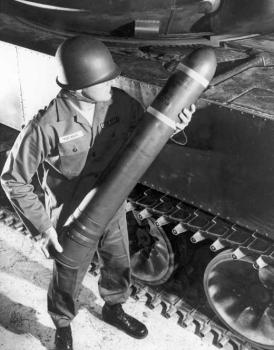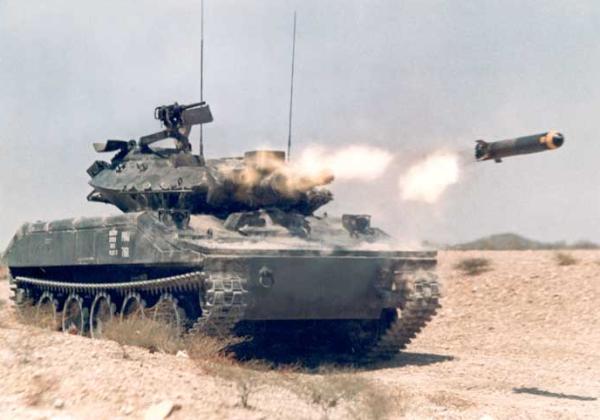Ford M13/MGM-51 Shillelagh
The MGM-51 Shillelagh was the first gun-launched guided missile deployed by the U.S. Army ground forces.
In the 1950s, the U.S. Army looked for improved anti-armour weapon systems for the modern battlefield, and in 1958, the Combat Vehicle Weapon System program was approved. This program called for the development of new fighting vehicles, as well as guided missile type anti-tank weapons for short and medium ranges. For the short-range missile, Sperry and Ford Aeronutronics submitted design proposals, and in June 1959, Ford received a development contract for their system. The Ford missile was designated as Guided Missile, Armour Defeating, XM13, and named Shillelagh. The first launch of a Shillelagh prototype occurred in November 1960, and the test shots of guided rounds began in September 1961. In June 1963, the XM13 Shillelagh was redesignated as XMGM-51A, and in 1964 limited production of the XMGM-51A, together with the XMTM-51A training rounds, began. In May 1966, the Shillelagh was designated as standard equipment, and the tactical and training rounds were redesignated as MGM-51A and MTM-51A, respectively. In January 1967, the MGM-51A was first fielded by operational U.S. Army units.
The primary deployment vehicle for the Shillelagh missile was the M551 Sheridan AFV (Armoured Fighting Vehicle), which could also fire conventional unguided M409 HEAT (High-Explosive Anti-Tank) rounds from its M81 gun. A typical loadout consisted of 8 Shillelagh missiles and 20 M409 rounds. In a Shillelagh shot, the gunner aimed the cross-hairs in his telescopic sight at the target, and fired the missile. After launch through the cannon, the missile's solid-fueled sustainer rocket ignited, and propelled the Shillelagh to flying speed (source [1] claims a speed of about 4200 km/h (2600 mph), but this seems to be way too high). For the time of flight of the round, the gunner had to keep the cross-hairs pointed at the target. A missile tracker in the gunner's sight detected any deviation of the flight path from the line-of-sight to the target, and transmitted corrective commands to the missile via an infrared command link. The MGM-51A was stabilized by flip-out fins, and controlled by hot gas jet reaction controls. The missile's 6.8 kg (15 lb) shaped charge warhead detonated on impact. Although strictly a short range (2000 m (6600 ft) max) line-of-sight weapon, the MGM-51A Shillelagh was an accurate missile even against moving targets. There were also some drawbacks, one of which was the relatively high minimum range of about 730 m (2400 ft). From launch until this distance, the MGM-51A flew below the line-of-sight of the tracking system's infrared beam and could therefore not be guided. Because the minimum range was slightly above the maximum effective range of the M551 Sheridan's conventional unguided munition, this created a dangerous "dead range" for the AFV. A Shillelagh missile was also rather expensive compared to conventional anti-armour rounds.
 |
| Photo: U.S. Army |
| MGM-51 (exact model unknown) |
In 1963, the U.S. Army awarded Ford a contract to study the possibility of extending the Shillelagh's range by about 50 percent. In 1964, Ford proposed a slightly longer and heavier, but otherwise essentially unchanged missile. Flight tests of XMGM-51B evaluation rounds began in May 1965, and in October 1966, the extended range Shillelagh was approved for production as MGM-51B. The MTM-51B was the corresponding training round.
To prevent missile roll during gun launch, the Shillelagh used a longitudinal key, which fitted into a keyway inside the gun barrel. The key of the MGM-51A/B was 3.3 mm (.130 in) deep and 25.4 cm (10 in) long. During tests in the 1964 time frame, it was discovered that structural cracks in the barrel occurred after a few hundred Shillelagh shots, and the origin of these cracks could be traced to the missile keyway. It was determined that a less deep key would significantly extend the service life of the barrel. During tests in 1966 with missiles of shallower key, the optimum key depth was found to be 1.9 mm (.075 in). After further test, the shallow-key missile was approved for production and service use in January 1968, and designated MGM-51C. As for the MGM-51A/B variants, there was also a training round of the MGM-51C, designated MTM-51C. Between August 1968 and February 1969, all deep-key MGM-51Bs were converted to MGM-51C configuration. Shallow-key missiles could also be fired from deep-key barrels, but not vice versa, of course. The shallow-key gun launcher was known as M81E1.
 |
| Photo: U.S. Army |
| MGM-51 (exact model unknown) |
Apart from the M551 Sheridan, the only other delivery system for the Shillelagh was the M60A2 tank, developed from the M60A1 model via the interim M60A1E1 and M60A1E2. The M60A2 replaced the M60A1's turret with a new 152 mm gun turret compatible with Shillelagh, and the usual load was 13 missiles and 33 unguided rounds. After initial tests in 1966/67, the M60A2 was first fielded in 1974, after delays caused by technical problems. However, the M60A2/Shillelagh system was plagued by severe reliability problems, and was already phased out in 1980.
The Shillelagh was in production until 1971, and a total of about 88000 MGM/MTM-51 missiles of all variants were built, including 12500 by Martin Marietta. Phaseout of the M551/Shillelagh system began in 1978, and in 1980 only a single active Airborne Battalion retained the M551. In the U.S. Army National Guard, the M551 was finally retired in 1984. However, the one active Army M551 unit kept these systems until 1991, and actually deployed during Operation Desert Storm (although no Shillelagh shot was fired). It can be assumed, that the last M551 vehicles and MGM-51C Shillelagh missiles were removed from the inventory soon after. The main replacement for Shillelagh as a mobile anti-armour missile was the significantly more versatile BGM-71 TOW.
Specifications
Note: Data given by several sources show slight variations. Figures given below may therefore be inaccurate!
Data for MGM-51A/B/C:
| MGM-51A | MGM-51B/C | |
|---|---|---|
| Length | 1.11 m (3 ft 7.7 in) | 1.15 m (3 ft 9.4 in) |
| Finspan | 29.2 cm (11.5 in) | |
| Diameter | 15.2 cm (6 in) | |
| Weight | 26.8 kg (59.1 lb) | 27.8 kg (61.3 lb) |
| Speed | ? | |
| Range | 2000 m (6600 ft) | 3000 m (10000 ft) |
| Propulsion | Amoco Chemicals solid-fueled rocket | |
| Warhead | 6.8 kg (15 lb) shaped charge | |
Main Sources
[1] Bill Gunston: "The Illustrated Encyclopedia of Rockets and Missiles", Salamander Books Ltd, 1979
[2] R.T. Pretty, D.H.R. Archer (eds.): "Jane's Weapon Systems 1972-73", Jane's, 1973
[3] Redstone Arsenal Historical Information Website
Back to Current Designations Of U.S. Unmanned Military Aerospace Vehicles
Back to Directory of U.S. Military Rockets and Missiles
Last Updated: 16 June 2002